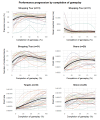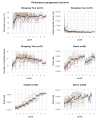Domain-Specific Evaluation of Exergame Metrics Among Older Adults With Mild Neurocognitive Disorder: Secondary Analysis of 2 Randomized Controlled Trials
- PMID: 40397948
- PMCID: PMC12138312
- DOI: 10.2196/65878
Domain-Specific Evaluation of Exergame Metrics Among Older Adults With Mild Neurocognitive Disorder: Secondary Analysis of 2 Randomized Controlled Trials
Abstract
Background: Exergame-based training enhances physical and cognitive performance in older adults, including those with mild neurocognitive disorder (mNCD). In-game metrics generated from user interactions with exergames enable individualized adjustments. However, there is a need to systematically investigate how well such game metrics capture true cognitive and motor-cognitive performance to provide a more robust basis for personalized training.
Objective: The primary objective was to identify valid game metrics as indicators for in-game domain-specific cognitive performance during exergaming in individuals with mNCD. We also aimed to explore game metric performance changes over time during exergame-based training.
Methods: Data were analyzed from individuals with mNCD who completed a 12-week home-based, exergame-based intervention following the Brain-IT training concept. A cross-sectional analysis was conducted by correlating game metrics with standardized neurocognitive reference assessments. To confirm the alternative hypothesis, we predetermined the following criteria: (1) statistically significant correlation (P≤.05; uncorrected; 1-sided) with (2) a correlation coefficient (Pearson r or Spearman ρ) of ≥0.4. Visual and curve-fitting longitudinal analyses were conducted to explore game performance changes over time.
Results: Data were available from 31 participants (mean age 76.4, SD 7.5 y; n=9, 29% female). In total, 33% (6/18) of the game metrics were identified as valid indicators for in-game cognitive performance during exergaming. In the neurocognitive domain of learning and memory, these metrics included the mean reaction time (ρ=-0.747), the number of collected items (ρ=0.691), and the precision score (r=-0.607) for the game Shopping Tour (P<.001 in all cases), as well as the point rate (P=.008; r=0.471) for the game Simon. In addition, point rate was a valid indicator for executive function (P=.006; r=0.455) and visuospatial skills (P=.02; r=0.474) for the games Targets and Gears, respectively. The exploratory longitudinal analysis revealed high interindividual variability, with a general trend of the expected typical curvilinear curves of rapid initial improvements followed by a plateau in performance.
Conclusions: This study demonstrated that metrics reflecting the precision of responses generally performed better than metrics reflecting the speed of responses. These observations highlight the importance of selecting valid game metrics for implementation in exergame designs. Further research is needed to explore the potential of game metrics and identify factors contributing to individual variability in in-game performance and performance progression, as well as identifying and adopting strategies that facilitate individual learning success and thus promote effectiveness in improving health outcomes.
Keywords: cognition; exergaming; game metrics; neurocognitive disorder; older adults; performance progression.
©Wanda Kaiser, Eling D de Bruin, Patrick Manser. Originally published in JMIR Serious Games (https://games.jmir.org), 21.05.2025.
Conflict of interest statement
Conflicts of Interest: None declared.
Figures
Similar articles
-
Effectiveness of an Individualized Exergame-Based Motor-Cognitive Training Concept Targeted to Improve Cognitive Functioning in Older Adults With Mild Neurocognitive Disorder: Study Protocol for a Randomized Controlled Trial.JMIR Res Protoc. 2023 Feb 6;12:e41173. doi: 10.2196/41173. JMIR Res Protoc. 2023. PMID: 36745483 Free PMC article.
-
Feasibility, usability, and acceptance of "Brain-IT"-A newly developed exergame-based training concept for the secondary prevention of mild neurocognitive disorder: a pilot randomized controlled trial.Front Aging Neurosci. 2023 Sep 21;15:1163388. doi: 10.3389/fnagi.2023.1163388. eCollection 2023. Front Aging Neurosci. 2023. PMID: 37810620 Free PMC article.
-
The feasibility of a stepping exergame prototype for older adults with major neurocognitive disorder residing in a long-term care facility: a mixed methods pilot study.Disabil Rehabil. 2023 Feb 23:1-15. doi: 10.1080/09638288.2023.2182916. Online ahead of print. Disabil Rehabil. 2023. PMID: 36824039
-
Folic acid supplementation and malaria susceptibility and severity among people taking antifolate antimalarial drugs in endemic areas.Cochrane Database Syst Rev. 2022 Feb 1;2(2022):CD014217. doi: 10.1002/14651858.CD014217. Cochrane Database Syst Rev. 2022. PMID: 36321557 Free PMC article.
-
Experiences of older adults participating in dance exergames: A systematic review and meta-synthesis.Int J Nurs Stud. 2024 Apr;152:104696. doi: 10.1016/j.ijnurstu.2024.104696. Epub 2024 Jan 15. Int J Nurs Stud. 2024. PMID: 38301305
Cited by
-
Home-Based Virtual Reality Training for Enhanced Balance, Strength, and Mobility Among Older Adults With Frailty: Systematic Review and Meta-Analysis.JMIR Serious Games. 2025 Jul 18;13:e67146. doi: 10.2196/67146. JMIR Serious Games. 2025. PMID: 40680186 Free PMC article. Review.
References
-
- Risk reduction of cognitive decline and dementia: WHO guidelines. World Health Organization. 2019. [2024-04-29]. https://www.who.int/publications/i/item/risk-reduction-of-cognitive-decl... . - PubMed
-
- Ge S, Zhu Z, Wu B, McConnell E. Technology-based cognitive training and rehabilitation interventions for individuals with mild cognitive impairment: a systematic review. BMC Geriatr. 2018 Sep 15;18(1):213. doi: 10.1186/s12877-018-0893-1. https://bmcgeriatr.biomedcentral.com/articles/10.1186/s12877-018-0893-1 10.1186/s12877-018-0893-1 - DOI - DOI - PMC - PubMed
-
- Chan AT, Ip R, Tran J, Chan JY, Tsoi K. Computerized cognitive training for memory functions in mild cognitive impairment or dementia: a systematic review and meta-analysis. NPJ Digit Med. 2024 Jan 03;7(1):1. doi: 10.1038/s41746-023-00987-5. https://doi.org/10.1038/s41746-023-00987-5 10.1038/s41746-023-00987-5 - DOI - DOI - PMC - PubMed
-
- Manser P, Herold F, de Bruin ED. Components of effective exergame-based training to improve cognitive functioning in middle-aged to older adults - a systematic review and meta-analysis. Ageing Res Rev. 2024 Aug;99:102385. doi: 10.1016/j.arr.2024.102385. https://linkinghub.elsevier.com/retrieve/pii/S1568-1637(24)00203-4 S1568-1637(24)00203-4 - DOI - PubMed
LinkOut - more resources
Full Text Sources




